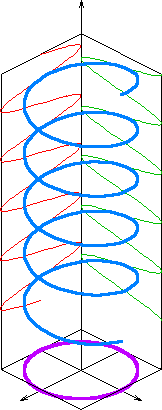In electrodynamics, circular polarization of electromagnetic radiation is a polarization such that the tip of the electric field vector, at a fixed point in space, describes a circle as time progresses. The name is derived from this fact. The electric vector, at one point in time, describes a helix along the direction of wave propagation (see the polarization article for pictures). The magnitude of the electric field vector is constant as it rotates. Circular polarization is a limiting case of the more general condition of elliptical polarization. The other special case is the easier-to-understand linear polarization.

Circular (and elliptical) polarization is possible because the propagating electric (and magnetic) fields can have two orthogonal components with independent amplitudes and phases (and the same frequency).
A circularly polarized wave may be resolved into two linearly polarized waves, of equal amplitude, in phase quadrature (90 degrees apart) and with their planes of polarization at right angles to each other.
Circular polarization may be referred to as right or left, depending on the direction in which the electric field vector rotates. Unfortunately, two opposing, historical conventions exist. In physics and astronomy, polarization is defined as seen from the receiver, such as a telescope or radio telescope. By this definition, if you could stop time and look at the electric field along the beam, it would trace a helix which is the same shape as the same-handed screw. For example, right circular polarization produces a right threaded (or forward threaded) screw. In the U.S., Federal Standard 1037C also defines the handedness of circular polarization in this manner. In electrical engineering, however, it is more common to define polarization as seen from the source, such as from a transmitting antenna. To avoid confusion, it is good practice to specify "as seen from the receiver" (or transmitter) when polarization matters.
hgjlkjhlkhj